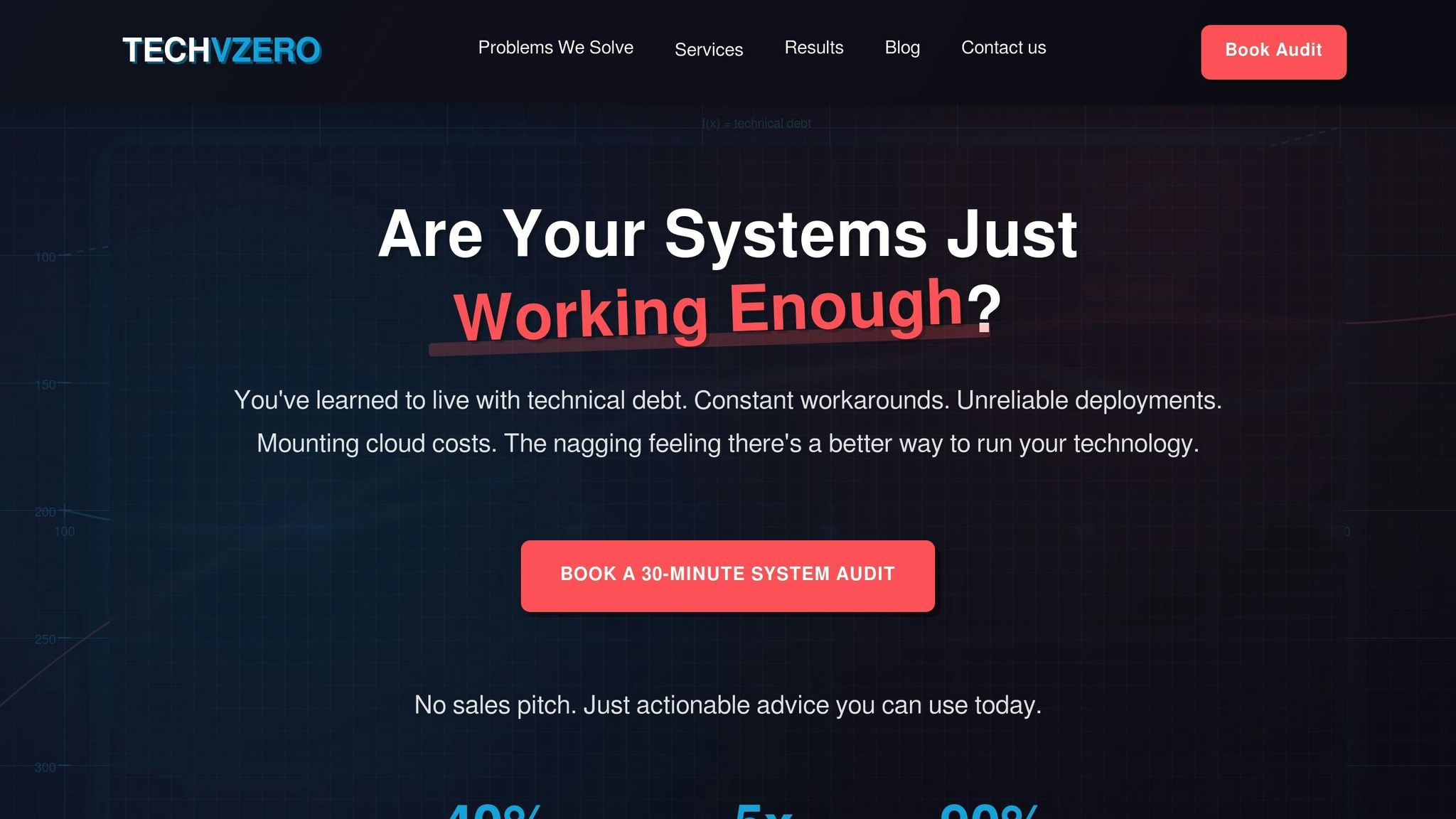Ultimate Guide to AI-Enhanced Multi-Cloud Cost Analysis

Managing multi-cloud costs is tough, but AI makes it easier. By automating analysis and optimizing resources, AI helps businesses reduce expenses and improve efficiency across platforms like AWS, Azure, and Google Cloud. Key challenges include limited visibility, governance issues, and complex optimizations. AI tackles these with real-time insights, automated scaling, and smarter resource allocation.
Key Takeaways:
- Visibility: AI consolidates billing data for a unified view of expenses.
- Governance: Automated policies enforce accountability and compliance.
- Optimization: AI rightsizes resources, predicts costs, and balances workloads.
TECHVZERO specializes in AI-powered solutions, offering tools and services that simplify multi-cloud cost management. Their expertise ensures businesses save money while maintaining performance and security. AI-driven cost analysis is the future of cloud management.
Autonomous Al Agents for Cloud Cost Analysis – Ilya Lyamkin, Spotify

Main Challenges in Multi-Cloud Cost Analysis
Managing expenses across multiple cloud providers is no small feat. Traditional cost management methods often fall short, leaving organizations grappling with unique challenges. Let’s break down the three biggest hurdles in multi-cloud cost analysis.
Limited Cost Visibility
Every cloud provider comes with its own pricing structures and billing systems, making it tough to get a unified view of your spending. Costs are often scattered across multiple dashboards, forcing finance teams to spend countless hours piecing together reports just to understand where the money is going.
To make matters worse, providers update their billing data at different times and with varying levels of detail. Some services provide near-instant updates, while others take hours or even days. This delay creates blind spots, making it nearly impossible to get an accurate, real-time picture of your cloud expenses. Without timely and consolidated data, optimizing costs becomes a guessing game.
Governance and Accountability Issues
In a multi-cloud environment, figuring out who’s responsible for what can feel like solving a giant puzzle. Different teams often gravitate toward different cloud providers, which complicates efforts to track spending and assign accountability.
Take cross-departmental chargebacks, for example. Allocating costs across teams is already tricky, but when resources span multiple clouds, it becomes even harder to ensure fairness and accuracy. Traditional allocation methods often fail in these scenarios.
Then there’s the issue of shadow IT – when employees create resources on various cloud platforms without proper approval. Each provider has unique access controls and monitoring tools, making it difficult for IT teams to maintain oversight. This lack of visibility can lead to unexpected and unauthorized expenses.
Compliance adds yet another layer of complexity. Cloud providers handle data governance, security, and audit trails differently, making it a challenge to maintain consistent standards across platforms. Keeping costs under control while meeting compliance requirements demands extensive coordination and expertise.
Optimization Complexities
Optimizing resources in a multi-cloud setup is far from straightforward. Each platform has its own instance types, pricing options, and optimization tools, creating a maze of variables to navigate.
Overprovisioning is a common issue that often flies under the radar. You might have fine-tuned resources on one platform while overspending on oversized instances elsewhere. Without unified analytics, these inefficiencies can linger for months, quietly draining your budget.
Deciding how to distribute workloads across providers adds another layer of complexity. Balancing cost, performance, and reliability requires a deep understanding of each platform’s pricing structures and capabilities.
Planning for reserved instances is equally tricky. To optimize reserved capacity, you need to forecast usage patterns for each provider while also accounting for potential shifts in workloads between platforms. This level of coordination is challenging without advanced tools.
Finally, automated scaling policies become harder to manage in a multi-cloud environment. Each provider has its own scaling triggers and capabilities, making it difficult to implement consistent strategies for cost optimization across your infrastructure.
These challenges highlight the need for smarter solutions, like AI-powered tools, to unify analytics and automate resource management across multiple clouds.
How AI Solves Multi-Cloud Cost Challenges
Managing costs across multiple cloud providers can be a daunting task. Traditional methods often rely on manual processes and struggle with the complexity of multi-cloud environments. This is where artificial intelligence steps in, simplifying the process by automating analysis and delivering smarter, faster ways to optimize costs.
AI-Driven Analytics for Cost Insights
AI excels at sifting through the massive amounts of data generated by different cloud platforms, offering real-time insights into spending patterns. For instance, it can detect anomalies, like a high-performance cluster left running by mistake, within hours – saving both time and money.
But AI doesn’t stop at spotting issues. With predictive cost modeling, it can forecast future expenses by analyzing historical usage, seasonal trends, and planned activities. For example, it might predict that your e-commerce platform will need extra resources during the holiday season and estimate the associated costs across providers.
AI also shines in cross-cloud correlation analysis, identifying how changes in one environment affect costs in another. This level of understanding is crucial when deciding whether to migrate workloads or tweak existing setups.
One of the most practical benefits is AI’s ability to simplify complex pricing structures. Instead of juggling different billing formats from multiple providers, AI consolidates this data into unified dashboards. These dashboards clearly show where your money is going and why, making it easier to take action. And because these insights feed directly into automated systems, cost adjustments can happen almost instantly.
Automation for Cost Optimization
AI-powered automation takes the guesswork out of resource management. Through intelligent rightsizing, AI continuously monitors resource usage and adjusts instance sizes based on actual needs, not outdated estimates. This ensures you’re only paying for what you truly use.
Automation also handles demand spikes with ease. AI can scale resources up or down automatically, ensuring a cost-effective allocation without sacrificing performance. Beyond instance sizing, recommendation engines provide actionable advice on reserved capacity planning, spot instance usage, and workload placement to maximize savings.
Policy enforcement is another area where AI proves invaluable. It can automatically enforce spending limits, block unauthorized resource creation, and ensure compliance with cost policies across all cloud platforms. AI also optimizes schedules by shutting down development environments during off-hours or scaling down non-critical services during low-demand periods, further cutting unnecessary expenses.
Smart Resource Allocation
AI takes resource allocation to the next level by balancing cost, performance, and business needs. Its algorithms consider factors like data gravity, latency, and pricing differences to determine the best placement for each workload.
With dynamic workload distribution, AI can shift applications between providers in real time. For example, if one provider offers better spot instance pricing for batch processing, AI redirects those workloads to capture the savings.
AI also brings precision to tagging and cost allocation. Machine learning can automatically categorize resources, assign them to the correct cost centers, and maintain consistent tagging across platforms. This ensures accurate chargebacks and eliminates the manual effort involved in managing resource categorization.
For long-term planning, AI offers intelligent forecasting for reserved capacity. By analyzing usage trends, it recommends the ideal mix of on-demand, reserved, and spot instances to minimize costs while meeting performance goals.
Data placement is another area where AI makes a difference. It analyzes data access patterns and automatically moves frequently accessed data to cost-effective locations. For example, it might suggest shifting data to cheaper storage tiers or replicating it across regions to balance cost and performance.
AI also streamlines resource lifecycle management. It predicts when resources are no longer needed, automatically archives or deletes unused assets, and ensures temporary resources don’t turn into permanent cost drains. And when it comes to prioritizing workloads, AI considers business needs and SLA requirements, giving critical production tasks access to premium resources while assigning cost-effective options to less demanding environments.
sbb-itb-f9e5962
Best Practices for Implementing AI in Multi-Cloud Cost Analysis
To make the most of AI in multi-cloud cost analysis, it’s essential to use structured frameworks like FinOps. This approach ensures cost visibility, automates processes, and enforces governance, leading to ongoing financial improvements. With AI-driven analytics, these frameworks help turn cost insights into practical strategies.
Adopting a FinOps Framework

The FinOps framework works through three key phases: Inform, Optimize, and Operate. These steps focus on creating cost transparency, improving resource allocation through data insights, and embedding cost management into everyday operations.
In a multi-cloud environment, applying FinOps requires collaboration across teams, standardizing cost tracking across different cloud providers, and using automation to maintain governance. This approach is crucial for achieving consistent cost savings and improving financial efficiency in cloud operations.
How TECHVZERO Supports AI-Driven Multi-Cloud Cost Analysis

TECHVZERO simplifies multi-cloud cost management by harnessing AI-powered insights and automation. Their approach combines expertise in data engineering with hands-on implementation services, allowing businesses to cut costs while maintaining top-notch performance across various cloud platforms. By aligning their tools with AI-driven practices and established FinOps methods, they ensure every cloud expense is both necessary and optimized.
TECHVZERO’s Expertise in Cost Reduction
TECHVZERO excels at reducing cloud costs through a data-driven strategy that transforms raw spending data into actionable insights using AI.
Their data pipeline architecture gathers real-time cost information from multiple cloud providers, presenting it in a centralized format. This unified view makes it easier to analyze costs across different platforms. Additionally, their data warehouse design enhances cost analysis by enabling faster, more accurate queries, which is critical for timely decision-making.
TECHVZERO’s real-time analytics tools are designed to instantly detect anomalies in cloud spending. This immediate visibility helps businesses quickly identify and address irregularities, preventing budget overruns before they become significant issues.
To further optimize costs, they provide intelligent automation services. These include self-healing systems that adjust resource allocation automatically based on actual usage, reducing the need for constant manual intervention while ensuring resources are used efficiently.
End-to-End Implementation Services
TECHVZERO doesn’t stop at analysis – they also offer comprehensive implementation services to enhance multi-cloud cost management. They focus on three key areas to strengthen cloud operations:
- DevOps Excellence: They streamline cloud operations by automating and scaling infrastructure management, creating a strong foundation for cost-effective processes.
- CI/CD Solutions: By automating testing, deployment, and rollback, they help businesses save time and resources while maintaining agility.
- Infrastructure as Code: This approach ensures version-controlled, repeatable infrastructure, avoiding configuration drift and enabling predictable scaling.
Their Kubernetes migration services assist businesses in adopting containerized applications, which support efficient scaling and consistent deployment patterns. Meanwhile, their DevSecOps integration embeds security at every stage of development, reducing the risk of costly security breaches and compliance issues.
TECHVZERO also emphasizes data governance and compliance, ensuring that data remains secure, high-quality, and aligned with regulatory standards – an essential element for accurate cost analysis and optimization.
Delivering Measurable Results
TECHVZERO’s solutions focus on delivering tangible outcomes, including reduced costs, faster deployments, and minimized downtime.
Their monitoring and incident recovery systems use automation to detect and resolve issues before they escalate, helping businesses avoid the steep costs associated with extended outages and manual troubleshooting. This proactive approach ensures smoother operations and fewer disruptions.
They also track metrics for cost savings and ROI, providing clear evidence of the financial impact of their optimization efforts. Detailed dashboards offer insights into spending patterns, highlight opportunities for savings, and measure the results of implemented changes.
Automation plays a key role in reducing manual labor and human errors. Self-healing systems handle common issues automatically, minimizing the need for after-hours support and reducing operational strain.
Additionally, TECHVZERO’s quick implementation process allows businesses to see results faster, speeding up the time-to-value for their cost optimization initiatives. This approach supports ongoing improvements based on real-world performance data.
Finally, their integrated security measures help mitigate the financial risks of data breaches and compliance violations. By embedding robust security protocols into cloud operations, TECHVZERO helps businesses avoid the hefty costs associated with such incidents while ensuring their systems remain secure and compliant.
Conclusion: Achieving Cost Savings with AI in Multi-Cloud Environments
AI-driven tools are reshaping how businesses handle cloud expenses across multiple platforms. By combining real-time analytics, automated optimization, and smart resource management, companies can cut costs without compromising performance. These advancements tackle some of the biggest hurdles in multi-cloud setups today.
Challenges like limited visibility, complex governance, and inefficient optimization are addressed head-on with AI. When paired with FinOps principles, this structured approach leads to more effective cost management strategies.
Beyond just saving money, AI-enhanced cost analysis brings additional benefits like faster deployments, less downtime, and better resource utilization. Automation also minimizes errors and reduces the workload involved in managing multi-cloud environments.
For organizations eager to adopt AI for multi-cloud cost optimization, TECHVZERO offers the expertise to make it happen. Their team specializes in data engineering, automation, and end-to-end implementation, helping businesses see tangible results quickly while setting the foundation for sustainable cost management.
The future of multi-cloud cost management lies with those who embrace AI solutions. Acting now means gaining an edge with lower costs, improved efficiency, and scalable cloud operations.
FAQs
How does AI enhance visibility and improve governance in multi-cloud environments?
AI is transforming how businesses manage visibility and governance in multi-cloud environments by offering centralized tools for monitoring and management across various cloud platforms. This allows organizations to keep a close eye on security, compliance, and data policies in real-time, ensuring that standards are consistently applied and minimizing the chances of policy breaches.
On top of that, AI can spot unusual activities and take over routine governance tasks like auditing and reporting. This proactive approach helps organizations tackle potential problems before they escalate. By automating these processes, AI not only strengthens security but also simplifies compliance efforts, making multi-cloud operations smoother and more dependable.
What are the key benefits of using AI for optimizing costs in a multi-cloud environment?
Using AI to manage multi-cloud costs comes with several major advantages:
- Lower expenses: AI can handle tasks like automating resource management, spotting unused resources, and fine-tuning usage. This can lead to savings of up to 30%.
- Real-time visibility: With AI, you get a clear view of all your cloud platforms, helping you make smarter choices and stay on top of costs.
- Adaptive resource management: AI uses predictive analytics and automated scaling to match resources with demand, cutting down on inefficiencies and reducing waste.
By integrating AI-driven tools, businesses can simplify their workflows, make better use of resources, and see noticeable cost savings across their multi-cloud environments.
How can businesses maintain compliance and accountability when managing multi-cloud costs with AI tools?
To keep things on track and ensure accountability in managing AI-powered multi-cloud costs, businesses need to set up well-defined governance policies. It’s also crucial to designate specific teams or departments to take charge of monitoring and managing cloud expenses. Using automated controls and alerts can make it easier to enforce these policies, helping to avoid overspending or unauthorized cloud usage.
Combining regular audits with real-time insights into cloud spending can provide transparency and ensure policies are followed. This not only curbs unnecessary expenses but also encourages stronger financial accountability throughout the organization.